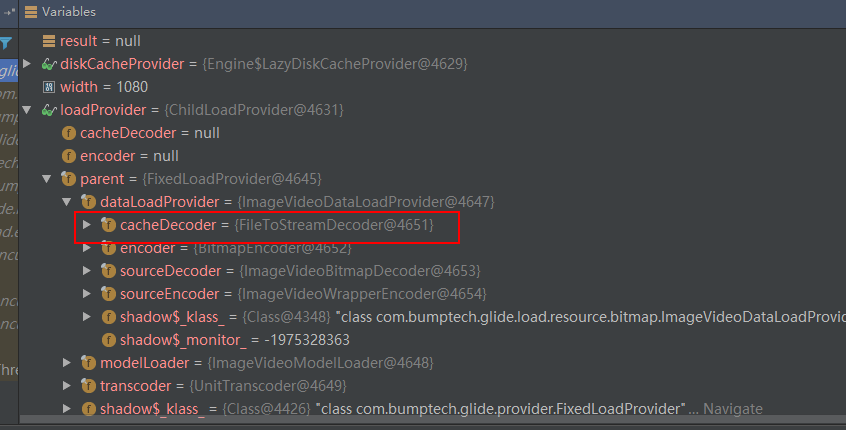Glide 显示视频缩略图及遇到的坑
实现原理
Glide支持视频格式的文件,但是在3.x里会有些欠缺。其底层是通过 MediaMetadataRetriever实现的。
MediaMetadataRetriever拥有获取视频的第几帧的能力,Glide获取视频里的第n帧的代码如下:
VideoBitmapDecoder.java
@Override
public Bitmap decode(ParcelFileDescriptor resource, BitmapPool bitmapPool, int outWidth, int outHeight,
DecodeFormat decodeFormat)
throws IOException {
MediaMetadataRetriever mediaMetadataRetriever = factory.build();
mediaMetadataRetriever.setDataSource(resource.getFileDescriptor());
Bitmap result;
if (frame >= 0) {
result = mediaMetadataRetriever.getFrameAtTime(frame);
} else {
result = mediaMetadataRetriever.getFrameAtTime();
}
mediaMetadataRetriever.release();
resource.close();
return result;
}
提取核心代码
mediaMetadataRetriever获取Bitmap的代码:
val file = FileInputStream(File(path))
val s = MediaMetadataRetriever()
s.setDataSource(file.fd)
file.close()
val bitmap = s.getFrameAtTime(-1)
imageView.setImageBitmap(bitmap)
s.release()
Glide3.x的一个bug
但3.x的Glide缓存策略不能是Source我们来分析各种缓存策略Glide的内部的逻辑
Result缓存策略
EngineRunnable.java
private Resource<?> decode() throws Exception {
if (isDecodingFromCache()) {
return decodeFromCache();
} else {
return decodeFromSource();
}
}
EngineRunnable分走两次,第一次走isDecodingFromCache
private Resource<?> decodeFromCache() throws Exception {
Resource<?> result = null;
//...ignore code
//先从result缓存里获取
result = decodeJob.decodeResultFromCache();
if (result == null) {
//再从源文件缓存里获取
result = decodeJob.decodeSourceFromCache();
}
return result;
}
第一次加载显示decodeResultFromCache会为空,我们略过,重点看decodeSourceFromCache
public Resource<Z> decodeSourceFromCache() throws Exception {
//如果不是cacheSource直接返回空
if (!diskCacheStrategy.cacheSource()) {
return null;
}
//...ignore code
}
decode失败以后会把EngineRunnable 扔给另外一个线程
private void onLoadFailed(Exception e) {
if (isDecodingFromCache()) {
stage = Stage.SOURCE;
manager.submitForSource(this);
} else {
manager.onException(e);
}
}
因此它会再一次走到run()方法里的decode,而此次走的是decodeFromSource
DecodeJob.java
public Resource<Z> decodeFromSource() throws Exception {
Resource<T> decoded = decodeSource();
return transformEncodeAndTranscode(decoded);
}
private Resource<T> decodeSource() throws Exception {
Resource<T> decoded = null;
try {
// 通过fetcher去加载Source
final A data = fetcher.loadData(priority);
//...ignore code
decoded = decodeFromSourceData(data);
} finally {
fetcher.cleanup();
}
return decoded;
}
DecodeJob.java
private Resource<T> decodeFromSourceData(A data) {
final Resource<T> decoded;
if (diskCacheStrategy.cacheSource()) {
decoded = cacheAndDecodeSourceData(data);
} else {
//因为缓存策略是Result,所以走的是该处
decoded = loadProvider.getSourceDecoder().decode(data, width, height);
//...ignore code
}
return decoded;
}
SourceDecode其实就是ImageVideoBitmapDecoder
public Resource<Bitmap> decode(ImageVideoWrapper source
, int width, int height){
Resource<Bitmap> result = null;
InputStream is = source.getStream();
if (is != null) {
//通过streamDecoder去decode图,它是StreamBitmapDecoder
result = streamDecoder.decode(is, width, height);
}
if (result == null) {
ParcelFileDescriptor fileDescriptor = source.getFileDescriptor();
if (fileDescriptor != null) {
//通过fileDescriptorDecoder去decode图,它是FileDescriptorBitmapDecoder
result = fileDescriptorDecoder.decode(fileDescriptor, width, height);
}
}
return result;
}
ImageVideoBitmapDecoder里有两种decoder
- StreamBitmapDecoder直接将输入流转成Bitmap
- FileDescriptorBitmapDecoder能将流通过VideoBitmapDecoder去转Bitmap
而VideoBitmapDecoder底层就是通过MediaMetadataRetriever去获取第一帧
如果源文件是视频,它将先通过StreamBitmapDecoder去decode,结果decode失败result=null
然后通过FileDescriptorBitmapDecoder去decode,可见这里Glide内部并不知道源文件是图片还是视频,所以先用图片的方式解
而图片方式解的时候也是去读它的头文件:
@Override
public Resource<Bitmap> decode(InputStream source, int width, int height) {
//通过downsampler去decode
Bitmap bitmap = downsampler.decode(source, bitmapPool, width, height, decodeFormat);
return BitmapResource.obtain(bitmap, bitmapPool);
}
@Override
public Bitmap decode(InputStream is, BitmapPool pool, int outWidth,
int outHeight, DecodeFormat decodeFormat) {
final ByteArrayPool byteArrayPool = ByteArrayPool.get();
final byte[] bytesForOptions = byteArrayPool.getBytes();
final byte[] bytesForStream = byteArrayPool.getBytes();
//此处用了Option池,值得学习!
final BitmapFactory.Options options = getDefaultOptions();
//...ignore code
final Bitmap downsampled =
downsampleWithSize(invalidatingStream, bufferedStream,
options, pool, inWidth, inHeight, sampleSize,
decodeFormat);
private static Bitmap decodeStream(MarkEnforcingInputStream is, RecyclableBufferedInputStream bufferedStream,
BitmapFactory.Options options) {
if (options.inJustDecodeBounds) {
is.mark(MARK_POSITION);
} else {
bufferedStream.fixMarkLimit();
}
//如果是视频文件此处无法decode出Bitmap
final Bitmap result = BitmapFactory.decodeStream(is, null, options);
//...ignore code
return result;
}
第一种decode失败会用第二种,也就是最终会走到VideoBitmapDecoder去解析
Source缓存策略
如果缓存策略是Source
private Resource<T> decodeSource() throws Exception {
Resource<T> decoded = null;
try {
final A data = fetcher.loadData(priority);
//...ignore code
decoded = decodeFromSourceData(data);
} finally {
fetcher.cleanup();
}
return decoded;
}
private Resource<T> decodeFromSourceData(A data) {
final Resource<T> decoded;
//因为是缓存Source因为走cacheAndDecodeSourceData方法
if (diskCacheStrategy.cacheSource()) {
decoded = cacheAndDecodeSourceData(data);
} else {
long startTime = LogTime.getLogTime();
decoded = loadProvider.getSourceDecoder().decode(data, width, height);
if (Log.isLoggable(TAG, Log.VERBOSE)) {
logWithTimeAndKey("Decoded from source", startTime);
}
}
return decoded;
}
private Resource<T> cacheAndDecodeSourceData(A data) {
SourceWriter<A> writer = new SourceWriter<A>(loadProvider.getSourceEncoder(), data);
//通过DisckCache把源文件缓存
diskCacheProvider.getDiskCache().put(resultKey.getOriginalKey(), writer);
//然后通过loadFromCache去加载缓存
Resource<T> result = loadFromCache(resultKey.getOriginalKey());
return result;
}
而加载缓存的Decoder是CacheDecoder,非常不幸它不是ImageVideoBitmapDecoder
private Resource<T> loadFromCache(Key key) {
File cacheFile = diskCacheProvider.getDiskCache().get(key);
if (cacheFile == null) {
return null;
}
Resource<T> result = null;
try {
result = loadProvider.getCacheDecoder().decode(cacheFile, width, height);
} finally {
if (result == null) {
diskCacheProvider.getDiskCache().delete(key);
}
}
return result;
}
它是FileToStreamDecoder,以下是截图

而FileToStreamDecoder的Decoder是StreamBitmapDecoder,最终它是把该文件当成图片解析 因此导致它失败,如果result==null,它还会走
diskCacheProvider.getDiskCache().delete(key);
所以如果是视频流,缓存策略是Source,它会很让你失望,不停的copy文件,再解,解失败再删除,一直这样下去
如果该源文件很大,会影响Glide的性能!
为了验证这一猜想,我们可以通过抓包工具看一下发生了什么:

结果它确实把这个视频存下来了,不过发现decode失败就会把它删除
所以,显示视频图的时候,一定切记不要用Source缓存策略,它不仅无法加载成功,而且会给你带来很大隐患
结束!